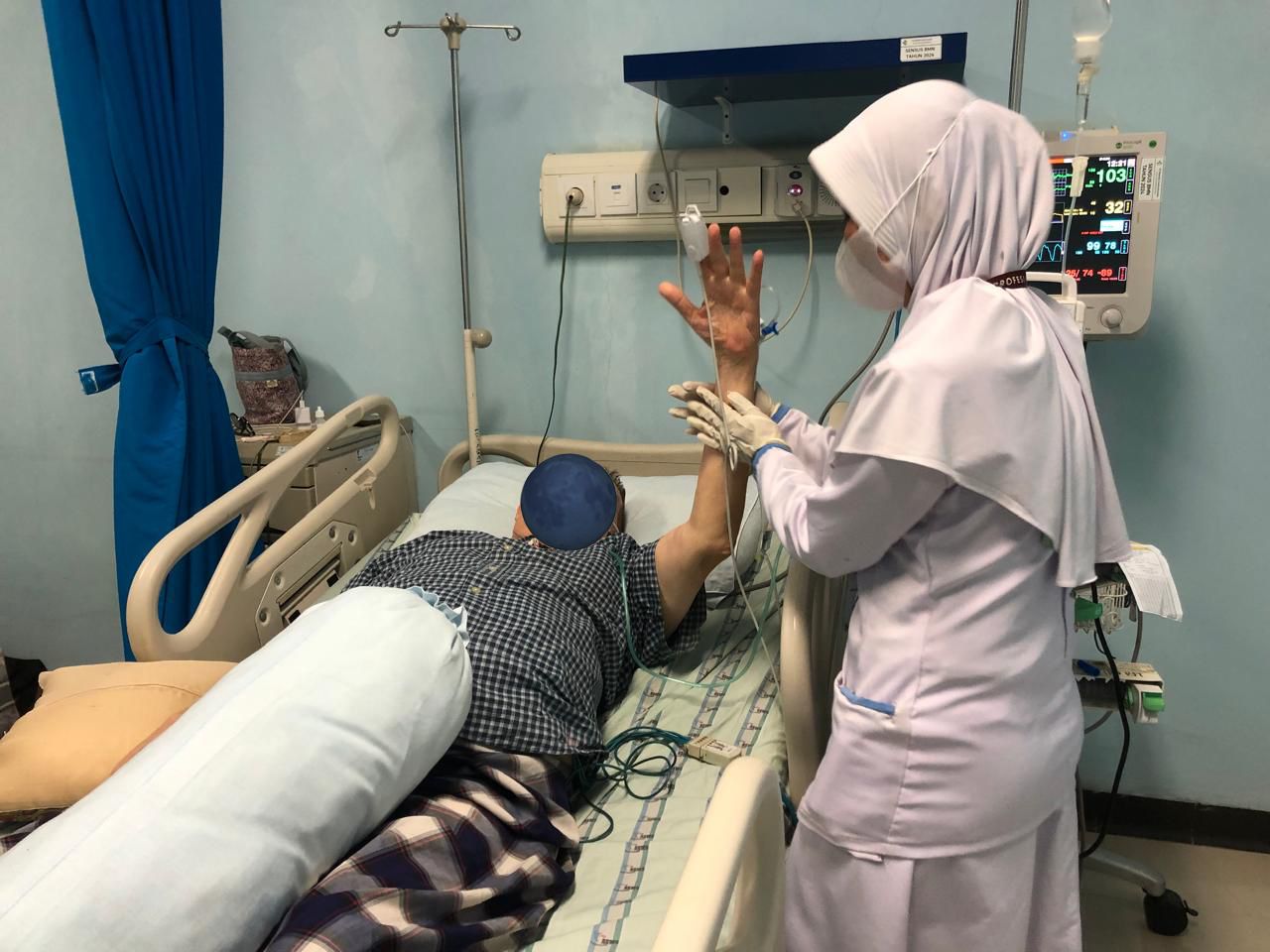Intervensi Non-Farmakologis untuk Bradikardia Simptomatik: Studi Mobilisasi Progresif dan Manajemen Energi di Ruang High Care Unit
DOI:
https://doi.org/10.55110/mcj.v4i2.251Keywords:
Symptomatic bradycardia, Hemodynamics, Energy management, Progressive mobilizationAbstract
Symptomatic bradycardia is a condition of slowed heart rate accompanied by symptoms such as dizziness, fatigue, and activity intolerance. Non-pharmacological interventions such as progressive mobilization and energy management are believed to improve patient hemodynamics. This study aimed to analyze the effects of progressive mobilization and energy management on hemodynamic parameters in a patient with symptomatic bradycardia. A descriptive case study was conducted on a 71-year-old male patient with symptomatic bradycardia, hypertension, and other comorbidities treated in the High Care Unit (HCU) of Dr. Wahidin Sudirohusodo Hospital. Interventions were carried out over three days, including passive exercises, active exercises, sitting, and structured energy-based activity management. Parameters of blood pressure, heart rate, respiratory rate, and oxygen saturation were recorded before and after the intervention. Results showed an increase in Barthel Index score from 2 to 8, stabilization of blood pressure and heart rhythm, and improved respiration. Progressive mobilization and energy management are effective in stabilizing hemodynamics and enhancing activity tolerance in symptomatic bradycardia patients.
Downloads
References
Chen, Z., Jin, Z.-X., Cai, J., Li, R., Deng, K.-Q., Ji, Y.-X., Lei, F., Li, H.-P., Lu, Z., & Li, H. (2022). Energy substrate metabolism and oxidative stress in metabolic cardiomyopathy. Journal of Molecular Medicine, 100(12), 1721–1739. https://doi.org/10.1007/s00109-022-02269-1
Egas, D., Rodriguez, F., Jaswal, A., Jeilan, M., Milasinovic, G., & Al Fagih, A. (2023). Burden of bradycardia and barriers to accessing bradycardia therapy in underserved countries. European Heart Journal Supplements, 25(Supplement_H), H1–H7. https://doi.org/10.1093/eurheartjsupp/suad125
Kakutani, N., Fukushima, A., Kinugawa, S., Yokota, T., Oikawa, T., Nishikawa, M., Nakamura, R., Tsukada, T., Mori, S., Yoshida, I., & Anzai, T. (2019). Progressive Mobilization Program for Patients With Acute Heart Failure Reduces Hospital Stay and Improves Clinical Outcome. Circulation Reports, 1(3), 123–130. https://doi.org/10.1253/circrep.CR-19-0004
Khurshid, S., Choi, S. H., Weng, L.-C., Wang, E. Y., Trinquart, L., Benjamin, E. J., Ellinor, P. T., & Lubitz, S. A. (2018). Frequency of Cardiac Rhythm Abnormalities in a Half Million Adults. Circulation: Arrhythmia and Electrophysiology, 11(7). https://doi.org/10.1161/CIRCEP.118.006273
Kim, Y. J., Radloff, J. C., Crane, P. A., & Bolin, L. P. (2019). Rehabilitation Intervention for Individuals With Heart Failure and Fatigue to Reduce Fatigue Impact: A Feasibility Study. Annals of Rehabilitation Medicine, 43(6), 686–699. https://doi.org/10.5535/arm.2019.43.6.686
Kitzman, D. W., Whellan, D. J., Duncan, P., Pastva, A. M., Mentz, R. J., Reeves, G. R., Nelson, M. B., Chen, H., Upadhya, B., Reed, S. D., Espeland, M. A., Hewston, L., & O’Connor, C. M. (2021). Physical Rehabilitation for Older Patients Hospitalized for Heart Failure. New England Journal of Medicine, 385(3), 203–216. https://doi.org/10.1056/NEJMoa2026141
Lee, M. K., Lee, C. J., Goo, S. Y., Lee, T. H., Moon, J. Y., Jung, J., Kim, M. J., Shin, S. H., Kim, J. N., Han, S. N., Lee, J. E., Lee, J. Y., Chung, I.-M., & Jeon, J. Y. (2024). Development and application of a home-based exercise program for patients with cardiovascular disease: a feasibility study. BMC Sports Science, Medicine and Rehabilitation, 16(1), 51. https://doi.org/10.1186/s13102-024-00835-3
Manoj, P., Kim, J. A., Kim, S., Li, T., Sewani, M., Chelu, M. G., & Li, N. (2023). Sinus node dysfunction: current understanding and future directions. American Journal of Physiology-Heart and Circulatory Physiology, 324(3), H259–H278. https://doi.org/10.1152/ajpheart.00618.2022
Passantino, A., Dalla Vecchia, L. A., Corrà, U., Scalvini, S., Pistono, M., Bussotti, M., Gambarin, F. I., Scrutinio, D., & La Rovere, M. T. (2021). The Future of Exercise-Based Cardiac Rehabilitation for Patients With Heart Failure. Frontiers in Cardiovascular Medicine, 8. https://doi.org/10.3389/fcvm.2021.709898
Rujichanuntagul, S., Sri-On, J., Traiwanatham, M., Paksophis, T., Nithimathachoke, A., Bunyaphatkun, P., Sukklin, J., & Rojsaengroeng, R. (2022). Bradycardia in Older Patients in a Single-Center Emergency Department: Incidence, Characteristics and Outcomes. Open Access Emergency Medicine : OAEM, 14, 147–153. https://doi.org/10.2147/OAEM.S351548
Santos, P. M. R., Ricci, N. A., Suster, É. A. B., Paisani, D. M., & Chiavegato, L. D. (2017). Effects of early mobilisation in patients after cardiac surgery: a systematic review. Physiotherapy, 103(1), 1–12. https://doi.org/10.1016/j.physio.2016.08.003
Shan, R., Ning, Y., Ma, Y., Liu, S., Wu, J., Fan, X., Lv, J., Wang, B., Li, S., & Li, L. (2021). Prevalence and risk factors of atrioventricular block among 15 million Chinese health examination participants in 2018: a nation-wide cross-sectional study. BMC Cardiovascular Disorders, 21(1), 289. https://doi.org/10.1186/s12872-021-02105-3
Shirzad, M., Tari, B., Dalton, C., Van Riesen, J., Marsala, M. J., & Heath, M. (2022). Passive exercise increases cerebral blood flow velocity and supports a postexercise executive function benefit. Psychophysiology, 59(12). https://doi.org/10.1111/psyp.14132
Steggall, A., Mordi, I., & Lang, C. (2017). Targeting Metabolic Modulation and Mitochondrial Dysfunction in the Treatment of Heart Failure. Diseases, 5(2), 14. https://doi.org/10.3390/diseases5020014
Sun, Y., Jin, H., & Wu, L. (2025). Impact of a refined nursing model combined with early exercise rehabilitation on patients with chronic heart failure under a risk assessment strategy. Frontiers in Cardiovascular Medicine, 12. https://doi.org/10.3389/fcvm.2025.1638025
Taylor, R. S., Dalal, H. M., & Zwisler, A.-D. (2023). Cardiac rehabilitation for heart failure: ‘Cinderella’ or evidence-based pillar of care? European Heart Journal, 44(17), 1511–1518. https://doi.org/10.1093/eurheartj/ehad118
Ueno, K., Kaneko, H., Itoh, H., Takeda, N., Morita, H., Fujiu, K., Kamiya, K., & Komuro, I. (2022). Effectiveness and Approach of Rehabilitation in Patients With Acute Heart Failure: A Review. Korean Circulation Journal, 52(8), 576. https://doi.org/10.4070/kcj.2022.0181
Ventura-Clapier, R. (2009). Exercise training, energy metabolism, and heart failureThis paper is one of a selection of papers published in this Special Issue, entitled 14th International Biochemistry of Exercise Conference – Muscles as Molecular and Metabolic Machines, and has under. Applied Physiology, Nutrition, and Metabolism, 34(3), 336–339. https://doi.org/10.1139/H09-013

Downloads
Published
How to Cite
Issue
Section
License
Copyright (c) 2025 Mando Care Jurnal

This work is licensed under a Creative Commons Attribution-ShareAlike 4.0 International License.











